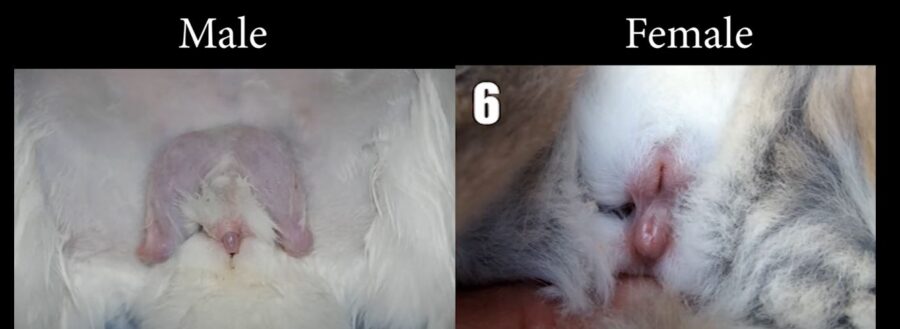You have arrived at the ultimate article to discover the differences between Male vs. Female Rabbits. These 23 things you need to know will be explained, but there are more lingering questions.
Is a male rabbit easier to take care of than a female? Can 2 female rabbits live together? Are there any clear, visual differences on the face of a female doe vs. a male buck?
In this article, I will share, explore and uncover what is needed to know about Male vs. Female Rabbits.
Male vs. Female Rabbits
It is difficult to tell the difference between male and female rabbits by simply looking at them.
Examining their genitals requires careful lifting and pressing gently in the area slightly above the anus to discover a protrusion that will indicate whether or not the rabbit is a male or female.
Folded skin and a vertical slit (vulva) identifies a doe while a tubular protrusion (penis) identifies a buck.

Female Rabbit Behavior
A sexually mature female could display negative behavioral traits such as:
- aggression
- territorial
- aloof
- dominance
She might be seen mounting both male and female rabbits to exert her dominance over a territory or on her counterparts.
Her aggression may end up transferring over to owners or her favorite human as well. She may become irritable or unresponsive when her name is called.
Male Rabbit Behavior
In about 3 to 6 months when male rabbits reach sexual maturity, they may switch from peaceful coexistence with each other too aggressive behaviors.
Male rabbits that are not neutered with genitals intact, are more likely to exert dominance or aggression over each other. If two new male rabbits are neutered, the chances of them living together peacefully are increased.
How Do Male Rabbits Behave?
Male rabbits exert different types of behaviors when they have reached sexual maturity such as spraying urine or rubbing scent glands that are located under their chin on objects to mark their spacing territory.
A male rabbit is known as a buck and can display some of the following behaviors when he is near a female doe rabbit.
- sniff
- lick
- nuzzle
- groom
- following the doe
- exhibit tail flagging
- mounting
9 Habits of Male rabbits
- It is generally acknowledged that male rabbits are easier to take care of than females. This is because they are not as aggressive in most cases.
- In the wild, male rabbits spend more time digging tunnels and foraging.
- They do not spend as much time trying to protect their territory.
- You are less likely to be bitten or swatted at by a male rabbit.
- Neutering a male rabbit is cheaper, easier, less invasive and a shorter overall procedure than a female rabbit getting spayed.
- One noticeable downside for owning male rabbits, is that they urinate more often around the room or spray to mark territory. This is an instinct that has developed to warn unfamiliar rabbits to stay away from their area.
- The urine of a male rabbit who has discreetly sprayed around the edges of a room can cause their acidic urine to damage wood floors or stain carpets more often than females.
- Male rabbits usually smell musky, especially when they are neutered. They are more likely to create an order in your house that is distinct.
- While female rabbits are not exempt from mounting, they do so out of aggression or exerting their dominance, but a male that is not neutered acts out by humping or mounting objects, people and other rabbits.
Is a Male Rabbit Easier to Take Care of Than a Female?
In many cases the behavioral habits of male rabbits tend to be less territorial. Males who reach sexual maturity are less destructive than females. Their personalities tend to be more relaxed.
Rabbits have individual personalities and the generalizations can be refuted when you clearly have a female that is calm, laid back and not territorial at all. There are always exceptions to every generalization.
The Differences Between Male and Female Rabbits
A difference between two rabbits does not rely necessarily on gender all the time. You must also take into account the species of the rabbit, breed, age, living conditions and whether or not they have been spayed or neutered. When the genitals of a rabbit are intact, there are more aggressive behaviors witnessed.

23 Things You Need To Know To Between Male vs. Female Rabbits
Remember that gender stereotypes and generalizations are combined with facts and anecdotal evidence in this ultimate list below.
Refuting some of these common tendencies are encouraged in a diverse ecosystem and unique behaviors of each individual rabbit.
- Male rabbits are less expensive to neuter.
- Males spray urine and it smells worse than females.
- Males tend to have friendlier personalities.
- Males mount more often than females and hump everything in sight during breeding season.
- Males are less territorial.
- Males are more aggressive to other males to defend a female.
- Males are less destructive.
- Males are calmer.
- A male rabbit usually has a block-like face or square-like face.
- Spaying females is more expensive than neutering.
- Aggression and mounting is reduced by removing genitals.
- Females reach maturity sooner
- Females are more territorial.
- Females wish to exert more dominance.
- False pregnancies in females cause them to build nests, pull carpet fibers or their own fur.
- Uterine cancer is common in females who are not spayed.
- Females wish to be the boss or in charge.
- Female rabbits have a rounder face.
- Females grow skinfolds under the neck as they get older.
- Females tend to be larger.
- Males rabbits are Bucks while females are Does.
- Folded skin and a vertical slit (vulva and vagina) identifies a doe while a tubular protrusion (penis) identifies a buck.
- Males urinate more than females during mating periods.
Is It Better to Have a Female or Male Rabbit?
If this is your first time taking care of a rabbit, choosing a male rabbit might be easier for you. Male rabbits are not as territorial and destructive as females.
Their personalities tend to be calmer. The chances of friendly, docile behaviors exhibited by male rabbits increase is when they are neutered.
Are Male Rabbits Calmer Than Females?
Yes. Males tend to be more relaxed than females. The buck is more focused on exploration, investigation and checking out new areas. In the wild, they are much more prevalent at digging tunnels to discover new treasures that may await.
A female tends to be the boss of the household and will remain put to guard and protect the territory with aggression or dominance. There are always exceptions to these generalizations and gender stereotypes.

Can 2 Female Rabbits Live Together?
Yes. Two rabbits living together that are female Does are recommended only when they have bonded. They may have grown up together from birth or bonded when arriving in a comfortable enclosure with lots of space.
Rabbits are social and if we offer them the right living situations, they will get along together. If they don’t, consider spaying the female rabbits and offering them more space in a larger enclosure.
Do Male Rabbits Smell More Than Females?
Yes. More often than not, male rabbits smell a little bit stronger than females. This could be due to the urine or scent glands of a male.
Unneutered male rabbits that have their genitals intact, tend to pee more often in areas around the home to mark their territory if they are allowed to free roam.
This odor will linger and can also create deeper stains on wood varnish and carpets. The smell of a male rabbit has been compared to a musky odor.
Can I Keep 2 Male Rabbits Together?
Yes. While it is possible to keep two male rabbits together, it is more successful to bond two females instead.
A pairing of two males must allow for one of the rabbits to be more submissive. If they are neutered, the chances of them getting along increases.
Male or Female Rabbit?
Male Rabbit
- Avg. height: 8–20”
- Avg. weight: 6-20 lbs
- Social Needs: Easy going but protective over females
Female Rabbit
- Avg. height: Up to 16”
- Avg. weight: 6 -20 lbs
- Social needs: Territorial
How to Tell a Male And Female Rabbit Apart
Knowing the difference between a male and female by simply looking at them is not good enough. You might think that female rabbits are larger and that’s good enough but there are many other factors in play.
Most importantly, a veterinarian, local breeder or an experienced rabbit caregiver can show you how to carefully lift a rabbit to inspect the genitals.
Two older male rabbits may not get along and placing a male and female together would be better served if they are spayed and neutered. Rabbits are social creatures and are going to be happy to live together under the right circumstances.

Are Male or Female Rabbits Bigger?
It is not as easy as measuring the size of a rabbit to tell if they are a male or a female. You have to also take into account their age, breed and diet.
A female is usually larger than a male of the same breed and age. She may also have larger ears. A buck may have spent more time exploring and using more calories to dig and discover new territories during their foraging sessions in the wild.
A female tends to stay put at home to defend the household where she doesn’t expel as much physical energy or burn as many calories.
Are Female Rabbits Aggressive?
A female rabbit is considered to be more aggressive than the male. A doe can be territorial who will also exhibit behaviors that are vocal or physical such as:
- growling
- grunting
- honking
- spraying
- lunging
Although they won’t bite, they will display dominance by mounting. If a female rabbit is spayed this will decrease her aggressiveness.
You would be better suited to a rabbit that is less destructive, and removing their genitals helps to do exactly as you wish while lowering her chances of developing uterine cancer.
A female rabbit who is not spayed, may try to dig burrows and carpets to build nests by pulling her own fur out of false pregnancy habits.
What Do Male Rabbit Genitals Look Like?
A male rabbit known as a buck, has a penis that is the shape of a tiny tube and the color is white or pink. You will not be able to see his testicles visible.
If the area above the anus is slightly pressed his penis will become more visible. On warmer days, the testicles might protrude as well. Male rabbits use their genitals more often for urination than females.
When they are sexually active, they can produce sperm at very healthy rates. Male urination is used to mark territories during breeding season. The urine of a male is known to be smellier with a musky odor.

How Do You Identify a Male Rabbit?
The male rabbit is known as a buck. The male reproductive system is obviously different than a female’s but the difficulty with telling genders apart from Rabbits is that these genitals are well hidden.
You will notice males mounting females when they are not neutered. Unfortunately, females might do the same and this might confuse you even further.
The most assured way that you can tell a male from a female is to find the sex organs. The penis of a rabbit buck is only visible when you slightly press the area above his anus.
Lifting a rabbit calmly without causing stress for you or this vulnerable creature must involve trust and patience. With experience, a rabbit will allow you to gently lift him up for you to attempt to press the area above the anus for the penis to become visible.
How to Identify a Female Rabbit
A female rabbit is commonly known as a doe. if she is of the same breed and age of her male counterpart, she will most likely be larger in size.
A female rabbit’s face is a rounder shape compared to the square like appearance of a male. This is not an easy way to identify male or female. The best way is to examine the genitals.
The area slightly above the anus has to be gently pressed in order to observe the vulva of her vagina. The vulva appears as folded skin that is pink and color. The vagina underneath is a vertical split. A female rabbit does not urinate as often as a male buck. Her habit is to stay in the nest and protect her territory.
Thank you for visiting PocketPetCentral.com for the best information to help you enjoy the life of your pocket pet companion in a fun, safe & healthy way.


